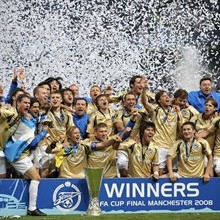History
Friday 26 September 2008 Zenit won their first European trophy when they lifted the 2008 UEFA Cup (©Getty Images)
Zenit won their first European trophy when they lifted the 2008 UEFA Cup (©Getty Images)The UEFA Cup, which will be renamed the UEFA Europa League in 2009/10, grew out of an idea conceived by Switzerland's Ernst Thommen who, along with Italy's Ottorino Barrasi and England's Sir Stanley Rous, later FIFA President, created a tournament for representative sides from European cities that regularly held trade fairs.
Forerunner
This forerunner to the UEFA Cup, the Inter-Cities Fairs Cup, was founded on 18 April 1955, two weeks after the founding of the European Champion Clubs' Cup. The first Fairs Cup involved teams from Barcelona, Basle, Birmingham, Copenhagen, Frankfurt, Lausanne, Leipzig, London, Milan and Zagreb. The original tournament lasted three years, with matches timed to coincide with trade fairs. Barcelona, using players purely from FC Barcelona, beat a London representative side 8-2 on aggregate in the final.
Club involvement
For the second tournament the organisers reverted to club participation but the teams still had to come from cities staging trade fairs. Sixteen clubs took part in the 1958-60 tournament, after which it was staged on an annual basis. By 1962 the number of entrants had risen to 32; there are now over 100. In its early years, teams from southern Europe dominated, notably Barcelona, who won it three times, and Valencia CF who won it twice. In 1968 Leeds United AFC became the first northern European club to win the trophy, heralding a run of six successive wins by English sides.
Name change
The fifth of these was in 1971/72, won by Tottenham Hotspur FC, and the first to be known as the UEFA Cup. The change of name was recognition of the fact the competition was now run by UEFA and no longer associated with the trade fairs. During the 1970s German, Dutch, Belgian and Swedish sides began to successfully compete with the English and between 1968 and 1984 only one team from the south – Juventus in 1977 – managed to disrupt the dominance of the northern Europeans.
Italian success
But following back-to-back victories by Real Madrid CF in the mid-1980s, Italian clubs took control in the 1990s. Starting with SSC Napoli's victory in 1989, Italian sides won the UEFA Cup eight times in eleven seasons, with FC Internazionale Milano winning it three times, before Galatasaray AŞ claimed it as Turkey's first European club prize in 2000. With the exception of 1964 and 1965, the final had, like the previous rounds, always been a two-legged, affair. The format changed permanently to a one-tie final in 1998 when Inter beat S.S. Lazio 3-0 at the Parc des Princes in Paris. Inter, Juventus and Liverpool share the record of three UEFA Cup final successes apiece. Sevilla FC, though, are catching up after their victories in 2006 and 2007 – emulating Madrid's feat of defending the trophy. Russia have opened their UEFA club football competition account in this tournament in recent years thanks to PFC CSKA Moskva in 2005 and FC Zenit St. Petersburg in 2008.
Competitions merge
From 1999/00, domestic cup winners also qualified for the UEFA Cup after the UEFA Cup Winners' Cup was disbanded. In addition, clubs eliminated from the third qualifying round of the UEFA Champions League and the eight third-placed finishers at the end of the group stage of the same competition entered the competition. The 2008/09 UEFA Cup also included three Fair Play representatives, eleven winners from the last UEFA Intertoto Cup and winners of some selected domestic league cup competitions. A group stage was introduced for the first time in 2004/05 involving 40 teams playing four games.
UEFA Europa League
On 26 September 2008, the UEFA Executive Committee decided that from 2009/10 the competition would become the UEFA Europa League. This reflected a change to the format previously agreed, with the group stage expanding to 48 clubs, who would play six matches on a home-and-away format similar to the UEFA Champions League.
Bertoni trophy
The trophy itself, which weighs 15kg and is silver on a yellow marble plinth, was designed and crafted by the Bertoni workshops in Milan for the 1972 final. It has no handles, its beauty lying in its simplicity. Just above the plinth, a group of players seem to be jostling for the ball. In fact they are supporting the octagonal cup which is emblazoned with the UEFA emblem.
©uefa.com 1998-2008. All rights reserved.







 »
»









